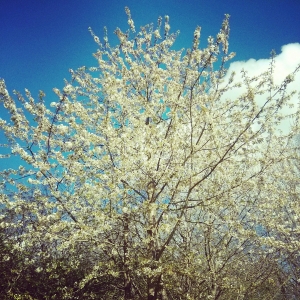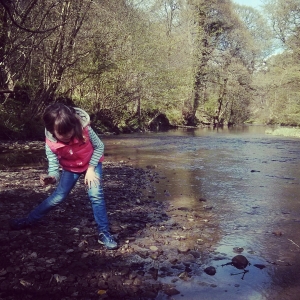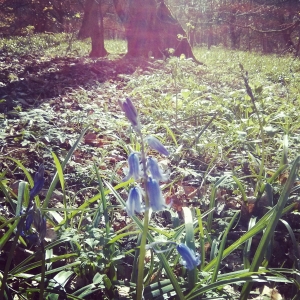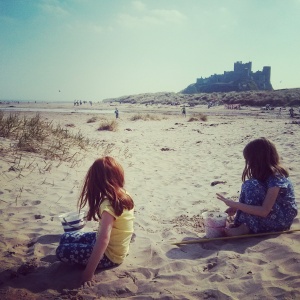“Like the blue sky, breaking up through the earth”
The bluebells are just starting to flower in Plessey Woods so I’m going to make sure I head back again next week, as I’ve heard it’s a wonderful sight.
Spotting signs of spring is a popular past time in our house at the moment. “Mummy, mummy, come and look at THIS!! Look NEW LEEEAVES!!!” And our walk to school takes twice as long as they fill their pockets with fallen blossom.
 I may not get as excited as my four-year-old but I do love spring and those first hints of the summer to come.
I may not get as excited as my four-year-old but I do love spring and those first hints of the summer to come.
 Another past time I also never seem to grow out of is stone skimming. There were some crackers down by the river today, dare I even say I think I found the perfect one?! Although I still lost out to the other half in the distance competition.
Another past time I also never seem to grow out of is stone skimming. There were some crackers down by the river today, dare I even say I think I found the perfect one?! Although I still lost out to the other half in the distance competition.
After much coaching and a few near knock outs (of me as stones came whizzing past my head) Charlotte managed to skim her first stone too, even if just two hops.
Her sister meanwhile looked more like she was auditioning for the highland games and was happier hurling small boulders in to the water, I kept my distance.
We then headed home via the play park, which is next to toilets (always handy!) and a small cafe.
There’s a good size car par that is now free too!
Plessey Woods Country Park (Bluebell Woods) is located near Hartford Bridge, off the A192, mid way between Bedlington and Cramlington and about 5 miles south of Morpeth.
The Park offers 100 acres of woodland, meadow and riverside to explore. The woodland is home to many birds such as the great spotted woodpecker, nuthatch and tree creeper, as well as animals including red squirrel, roe deer and fox. The banks of the River Blyth are also an important habitat for wildlife, such as kingfishers, dippers and otters.
http://www.northumberland.gov.uk/default.aspx?page=1892
Apparently our beloved bluebells are facing a fight for survival… read more here:
Other Bluebell Walks:
- I grew up in Middlesbrough so naturally Roseberry Topping has to be my number one. The walk through Newton Wood to the top is simply stunning http://www.northyorkmoors.org.uk/visiting/enjoy-outdoors/walking/our-walks/walking-routes/roseberry-topping-and-cooks-monument
- The National Trust recommends Allen Banks, Northumberland and
- Dunes behind Embleton Bay, Northumberland
- Ratcheugh Observatory & Bluebell Walk, Alnwick http://www.visitnorthumberland.com/outdoor-event/ratcheugh-observatory-bluebell-walk
-
Longacre Wood Hidden between the A1 at the Angel of the North and the main railway line this is Gateshead’s best bluebell wood with three ages of woodland to explore.
-
Northumberland Wildlife Trust suggests Goose’s Nest Bluebell Bank – This small site lies on a steep bank above the Ray Burn near Knowesgate and possesses a swathe of bluebells forming a magnificent display in late spring.
A few facts about Bluebells:
- In folklore, bluebells are also known as ‘fairy flowers’. It was believed that fairies used bluebells to trap passersby particularly small children,
- Other folklore tales would have us believe that by wearing a wreath made of bluebell flowers, the wearer would be compelled to speak only the truth. Or that if you could turn one of the flowers inside out without tearing it, you would eventually win the one you love.
- Bluebell plants are poisonous.
- 25-49% of the world’s population of bluebells are found in the UK.
- Bluebells can also be white. These rare individuals lack the pigment that gives bluebells their distinctive colour.
- The bluebell is being studied for its medicinal qualities because it contains things called water-soluble alkaloids that could be useful in developing drugs to fight cancer.
- “We love native bluebells for their wonderful scent of cooking apple, mango, lychees, ginger and freshly mown grass,” said Dr Trevor Dines, a botanist for Plantlife.
-
Alfred, Lord Tennyson described bluebells as ‘like the blue sky, breaking up through the earth’.





